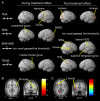Effect of acupuncture 'dose' on modulation of the default mode network of the brain
- PMID: 27841974
- PMCID: PMC5256125
- DOI: 10.1136/acupmed-2016-011071
Effect of acupuncture 'dose' on modulation of the default mode network of the brain
Abstract
Objective: Recent functional MRI (fMRI) studies show that brain activity, including the default mode network (DMN), can be modulated by acupuncture. Conventional means to enhance the neurophysiological 'dose' of acupuncture, including an increased number of needles and manual needle manipulation, are expected to enhance its physiological effects. The aim of this study was to compare the effects of both methods on brain activity.
Methods: 58 healthy volunteers were randomly assigned into four groups that received single needle acupuncture (SNA, n=15) or transcutaneous electrical nerve stimulation (TENS, n=13) as active controls, or enhanced acupuncture by way of three needle acupuncture (TNA, n=17) or SNA plus manual stimulation (SNA+MS, n=13). Treatment-associated sensations were evaluated using a visual analogue scale. Central responses were recorded before, during, and after treatment at LI4 on the left hand using resting state fMRI.
Results: TNA and SNA+MS induced DMN-insula activity and extensive DMN activity compared to SNA, despite comparable levels of de qi sensation. The TNA and SNA+MS groups exhibited a delayed and enhanced modulation of the DMN, which was not observed followed SNA and TENS. Furthermore, TNA increased precuneus activity and increased the DMN-related activity of the cuneus and left insula, while SNA+MS increased activity in the right insula.
Conclusions: The results showed that conventional methods to enhance the acupuncture dose induce different DMN modulatory effects. TNA induces the most extensive DMN modulation, compared with other methods. Conventional methods of enhancing the acupuncture dose could potentially be applied as a means of modulating brain activity.
Keywords: ACUPUNCTURE; NEUROLOGY.
Published by the BMJ Publishing Group Limited. For permission to use (where not already granted under a licence) please go to http://www.bmj.com/company/products-services/rights-and-licensing/.
Conflict of interest statement
Conflicts of Interest: None declared.
Figures



References
Publication types
MeSH terms
LinkOut - more resources
Full Text Sources
Other Literature Sources
Medical
Research Materials

